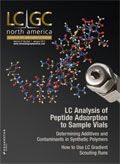Solid-Phase Extraction
An explanation of each stage in a typical SPE protocol
Solid-phase extraction (SPE) is a sample cleanup and preconcentration technique used to reduce sample and chromatographic complexity or increase analytical sensitivity.
Often called "digital chromatography," the technique uses silica or polymeric stationary phase particles that are often functionalized with various ligands to offer a particular selectivity to compounds partitioning between the liquid mobile phase and solid stationary phase surface. There are many different sorbent chemistries available, including most of the popular high performance liquid chromatography (HPLC) phases, ion exchangers (both weak and strong), and "mixed-mode" phases using both hydrophobic and ionic ligands. Polymers are used as mixed-mode phases and have found widespread use as "generic" phases in which a fixed protocol of solvents can be used across a wide variety of application types.

Figure 1: Steps in solid-phase extraction.
The sorbent materials are often packed into syringe barrel tubes or well-plate devices and protocol solvents are passed through the packed beds using gravity, vacuum, or positive pressure of an inert gas. The amount of sorbent is chosen to reflect the capacity required to retain the analytes of interest, although usually in SPE the mass of all sample components is considered in this calculation and not just the analyte of interest. Silica phases typically have a capacity of around 5% (w/w) by bed mass and polymers around 20% (w/w).
The majority of SPE methods — or protocols as they are often called — have six discrete stages. Sample pretreatment typically involves changing a liquid sample pH, dissolving a solid sample in a suitable solvent, or altering the sample buffer strength to ensure maximum retention by the chosen sorbent. Conditioning uses a solvent (often methanol) to activate the bonded phase on the sorbent surface and acts to avoid dewetting effects.
Equilibration prepares the sorbent surface to accept the sample, ensures optimum analyte recovery, and minimizes "breakthrough" — this might include adjusting the pH of the solvent within the sorbent bed, altering the ionic strength, or changing the type of buffer used. The adjustment of the solvent pH may also be used to control the degree of ionization for ligands containing ionogenic functional groups.
Sample loading is usually performed in a similar solvent to that used during the equilibration step, and careful control of solvent flow rate is important to ensure optimum analyte retention, especially where ionic (point to point) interactions are concerned. Flows rates of 1 mL/min are typical.
Washing steps require careful design of the protocol solvent and the eluotropic strength, ionic strength, and pH may all be adjusted to ensure that the maximum amount of potentially interfering species are removed while leaving the analyte in as tight a band as possible on the sorbent surface. The specificity of the protocol can be optimized, if required, by using ligands that undergo ion-exchange interactions where the options for chemically differentiating between analyte and interferents include pH, ionic strength, and the nature of the counterion used, thus creating cleaner final extracts. More than one washing step may be used if necessary. Method developers commonly use wash solvents that are eluotropically weaker than necessary for fear of analyte loss.
Elution protocol solvents are designed to recover the maximum amount of analyte from the stationary phase while leaving any remaining potential interferents behind, and once again, percentage of organic modifier, pH, ionic strength, and the nature of the counterion are available to maximize analyte recovery. Depending upon the nature of the wash and elution solvents and the mode of analyte retention, a soak step may be used in which the elution solvent is allowed to remain stationary for a fixed period of time, ensuring good penetration into the pores of the stationary phase, minimizing dewetting phenomena, and allowing time for the analyte to equilibrate into the elution solvent. Again, a common mistake at this stage is the use of protocol solvents that are "too strong'" and elute interfering compounds that could otherwise be left on the sorbent for fear of low analyte recovery. Both wash and elution stages should be carefully optimized to maximize selectivity of the process.
The volume of elution solvent can be altered with changing eutropic strength to achieve a concentration effect in which the analyte concentration increases with the ratio of sample volume to elution volume. If required, the elution solvent may be evaporated under an inert gas and reconstituted in a solvent more suited to the analytical technique or in a lower volume, again achieving an increase in analyte concentration. This evaporation or reconstitution step provides extra complexity and a possible reduction in precision and should be carefully considered.

Detecting Hyper-Fast Chromatographic Peaks Using Ion Mobility Spectrometry
May 6th 2025Ion mobility spectrometers can detect trace compounds quickly, though they can face various issues with detecting certain peaks. University of Hannover scientists created a new system for resolving hyper-fast gas chromatography (GC) peaks.
University of Oklahoma and UC Davis Researchers Probe Lipidomic Profiles with RP-LC–HRMS/MS
May 6th 2025A joint study between the University of Oklahoma Health Sciences Center (Oklahoma City, Oklahoma) and the UC Davis West Coast Metabolomics Center (Davis, California) identified differentially regulated lipids in type 2 diabetes (T2D) and obesity through the application of reversed-phase liquid chromatography-accurate mass tandem mass spectrometry (RP-LC-accurate MS/MS).
Automated Sample Preparation (ISO 20122) for MOSH/MOAH in Seasoning Oils
May 6th 2025This work presents an Automated Sample Preparation procedure for MOSH/MOAH analysis of Seasoning Oils. We compare results from a manual epoxidation procedure compliant with DIN 16995 with results based on fully automated sample preparation (epoxidation and saponification) compliant with ISO 20122. In both cases, online clean-up via activated aluminum oxide (AlOx) are used to remove interfering n-alkanes from the MOSH fraction during the HPLC run. Automated data evaluation using a dedicated software (GERSTEL ChroMOH) is presented.

.png&w=3840&q=75)

.png&w=3840&q=75)



.png&w=3840&q=75)



.png&w=3840&q=75)











